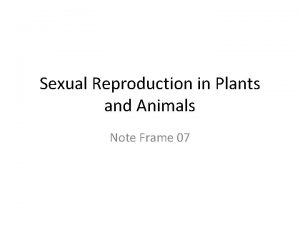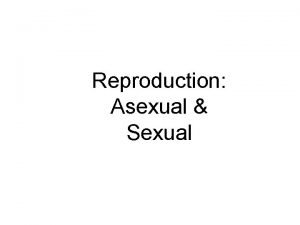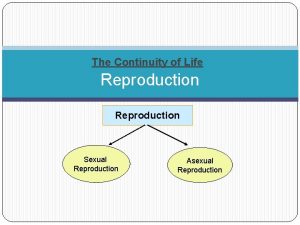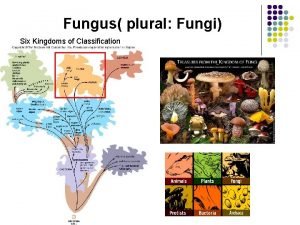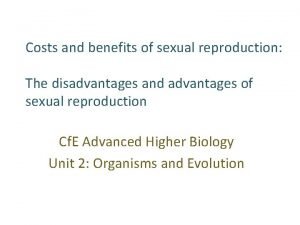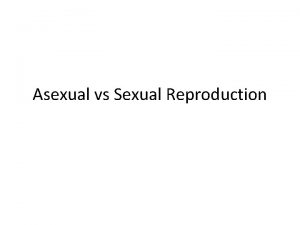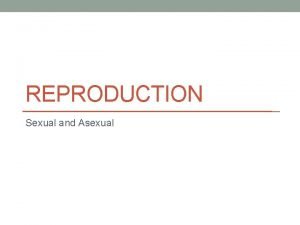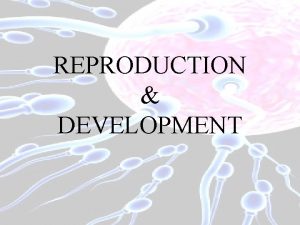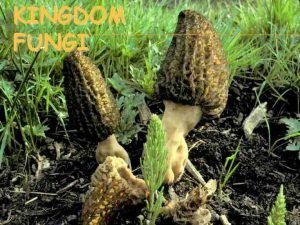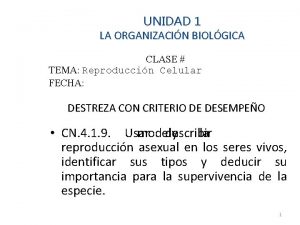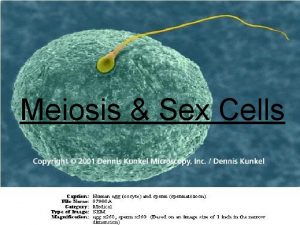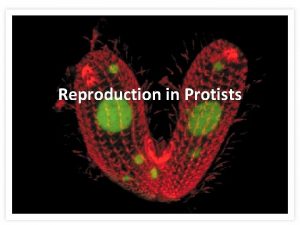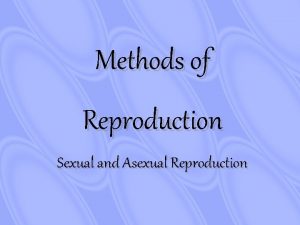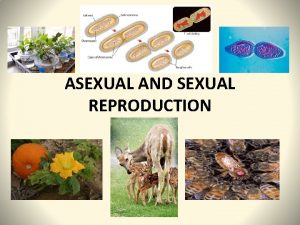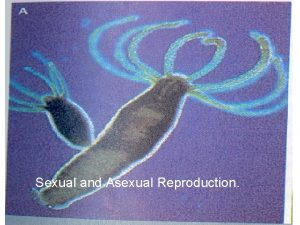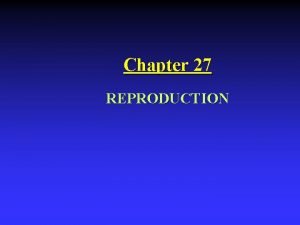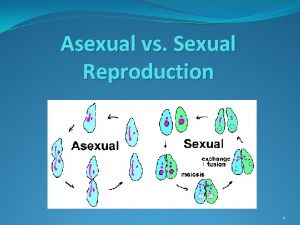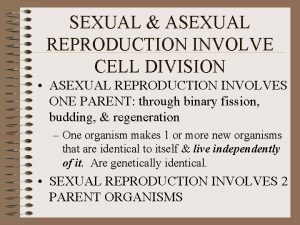Methods of Reproduction Sexual and Asexual Reproduction Asexual





















- Slides: 21

Methods of Reproduction Sexual and Asexual Reproduction

Asexual Reproduction: requires only 1 parent and the offspring are an exact copy of the parent---a clone

Asexual Reproduction: • Organisms that reproduce asexually cannot develop much variety, because they are “copying” the original organism exactly.

Methods of asexual reproduction: Binary fission Budding Fragmentation Parthenogenesis Spores Regeneration Vegetative Reproduction

Binary fission Bi= 2 Fision= splitting Binary Fission = asexual reproduction where a single cell splits in two new cells. The 2 new cells are exact copies of the original cell. *Single-celled organisms Amoeba, Paramecium, Euglena)

• When conditions are good, such as plenty of water, food, right temperatures, etc. , binary fission is a very effective way of producing many, many offspring. • For example, the cell of a Paramecium can divide, grow, and divide again in the space of 8 hours.

Spore Formation Fern Fungi • Spore Formation – happens in fungi, green algae, moulds and non flowering plants (e. g. ferns) – spores are produced and each spore develops into offspring which are identical to parent

Budding- an offspring grows out of the body of the parent. offspring Hydra Budding Cactus Budding

Budding In yeasts the cell does not divide equally in two halves; instead, there is a large mother cell and a smaller daughter cell. Yeast - budding

Fragmentation In this form, the body of the parent breaks into distinct pieces, each of which can produce an offspring. Example: Tape Worm

Regeneration A piece of the organism breaks off – and the organism can regrow from that piece. Pieces of coral broken off in storms can grow into new colonies. A new starfish can grow from one detached arm.

Parthenogenesis • Parthenogenesis is a form of asexual reproduction in which females produce eggs that develop without fertilization. • Parthenogenesis is seen to occur naturally in some invertebrates, along with several fish, amphibians, and reptiles as well as in many plants. • There are no known cases of parthenogenesis in mammals.

• Vegetative Reproduction – does not involve seeds – some offspring can grow from cuttings (e. g. coleus), runners (e. g. strawberries), tubers (e. g. potatoes) or bulbs (e. g. tulips)… which are part of the parent plant

What is sexual reproduction? • Requiring 2 parents – male and female (egg & sperm) • The egg and sperm join (zygote) to form an entirely new organism • Offspring are different from the parent organism because

Sexual Reproduction: Requiring 2 parents (egg & sperm) Combining different genetic material

Methods of sexual reproduction: Pollination External Fertilization Internal Fertilization

Sexual Reproduction in Plants pollen (male) + ovule (female) → single-celled zygote → multi-celled embryo (contained in a seed) → new individual

External Fertilization • External fertilization usually requires a medium such as water, which the sperms can use to swim towards the egg cell. External fertilization usually occur in fish and amphibians. • The females lay the eggs in the water and the male squirts the sperm in the same area.

Internal Fertilization • Fertilization occurs within the female. • Internal fertilization occurs in mammals, insects, birds, reptiles. – Mammals (gorillas, lions, elephants, rats, zebras, and dolphins have live births) – Insects, birds, reptiles lay eggs

Sexual Reproduction Summary Male Gamete Plants Female Gamete Type of Result of Union Final Result pollen ovule (egg) pollination single cell zygote multi-cell embryo (in seed) sperm egg fertilization single cell zygote multi-cell embryo Animals

Which is Better? It depends! Asexual Reproduction • advantages – does not require special cells or a lot of energy – can produce offspring quickly – in a stable environment creates large, thriving population • disadvantages – limited ability to adapt – face massive die-off if environment changes Sexual Reproduction • advantages – lots of variation within a species – able to live in a variety of environmental settings – able to adapt to changes in the environment • disadvantages – needs time & energy – produce small populations
 Sexual reproduction and asexual reproduction
Sexual reproduction and asexual reproduction Sexual reproduction vs asexual reproduction venn diagram
Sexual reproduction vs asexual reproduction venn diagram Venn diagram asexual vs sexual reproduction
Venn diagram asexual vs sexual reproduction Mitosis and meiosis
Mitosis and meiosis Venn diagram of meiosis and mitosis
Venn diagram of meiosis and mitosis Venn diagram sexual and asexual
Venn diagram sexual and asexual Is mitosis asexual
Is mitosis asexual Examples of reproduction
Examples of reproduction Where does cactus store water
Where does cactus store water Parthenogenesis in mammals
Parthenogenesis in mammals How the uniform offspring of your creature
How the uniform offspring of your creature Advantages of genetic diversity
Advantages of genetic diversity Sexual or asexual reproduction
Sexual or asexual reproduction Fungus diagram
Fungus diagram Sexual or asexual reproduction
Sexual or asexual reproduction Sexual or asexual reproduction
Sexual or asexual reproduction Sexual reproduction
Sexual reproduction Asexual or sexual reproduction
Asexual or sexual reproduction Spores sexual or asexual
Spores sexual or asexual Etapas de la reproducción humana
Etapas de la reproducción humana Bacteria sexual or asexual
Bacteria sexual or asexual Protist reproduction
Protist reproduction








